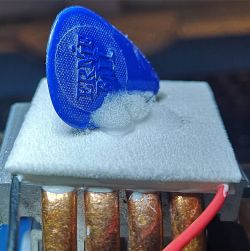Frenzy with performance is not there. I wonder what the efficiency would be if instead of the burner, we put a tourist gas lamp (one with Auer's T-shirt) on the gas canister and illuminate the spherically located photovoltaic cells around it.

Czy wolisz polską wersję strony elektroda?
Nie, dziękuję Przekieruj mnie tamQuote:Now for some details about the TEC1-12706
It is a normal coincidence that I have such an element in use.
Power supply 12 V - current 2.8 A, power 33 W.
The power given by the manufacturer / seller is 60 W, which is available with a power supply of about 15 V. How is the efficiency of such an element as a cooling one, another story.

puchalak wrote:To charge the phone, with this power, the lamp will have to be on for about 8 hours. What kind of material do you know that will burn for so long without maintenance?
kamil3211 wrote:Not. In such a generator, the role of the generator rotor is played by a liquid or gaseous (ionized) medium moving in a magnetic field.magnetohydrodynamic. Here, perhaps, thermal energy is immediately converted into electricity.
Andrzej42 wrote:But remember that Peltier cells do not "like" too high temperatures (probably around 100 ° C) because they will desolder.
skyinn wrote:How do you combine them?how much electricity will be produced if I connect 10 of these?
Quote:Copper oxide however, also acts like a thermistor with a very high negative temperature coefficient.
Staszek_Staszek wrote:Heat will quickly escape from the hot side to the cold side
Quote:the second electrode should be of a material other than copper.
Quote:It will not be a metal, but rather a semiconductor.
bambus94 wrote:Have you read the website and seen the video? It works, made of only copper wires.
